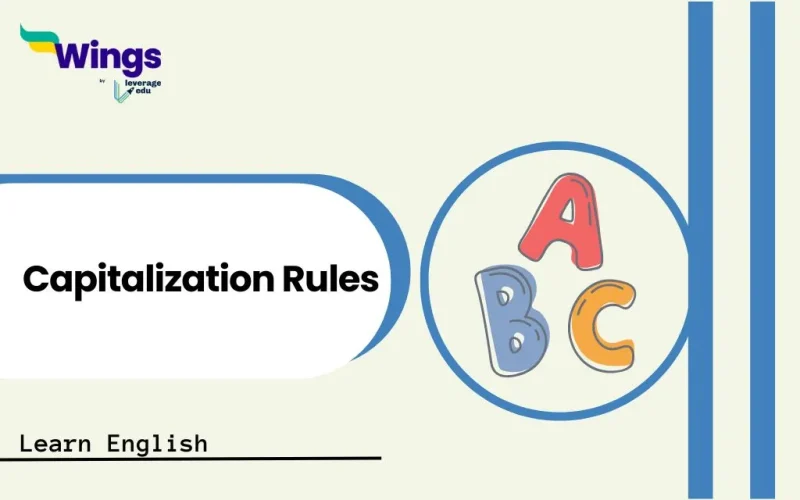For many English students, capitalization might seem like a minor detail in writing, but it plays a crucial role in clarity, professionalism, and overall readability. With proper capitalization, the reader can distinguish between different types of words and contribute to a polished final product. To help you perfect your capitalization and show respect for the language and its conventions, we have prepared an easy-to-understand guide to master this topic. We will break down the key capitalization rules, provide examples for better understanding, and address common questions that often arise regarding this topic. Make sure you keep reading this blog.
This Blog Includes:
Read more on English grammar here!
What is Capitalization?
Before we begin with the rules, let us look at the definition of ‘capitalization.’ Capitalization `involves using uppercase letters at the beginning of sentences and for specific words to indicate importance or distinction. For instance, proper nouns—names of people, places, organizations, and brands—are always capitalized to signify their unique status.
Why Are Capitalization Rules Important?
Applying capitalization rules correctly during sentence formation can significantly affect readability and show professionalism in one’s writing. Additionally, it helps one avoid ambiguity and ensures that your audience understands your message clearly. Upon mastering these rules, one can enhance their writing skills and boost your confidence in various contexts.
Join us as we delve into the intricacies of capitalization and improve your writing skills!
Quick Read: Capital Letters and Punctuation: Rules And Usage
Top 5+ Capitalization Rules That You Must Know!
As we have established having an understanding of capitalization is crucial for clear and effective communication in writing. Below are the top 20 capitalization rules that will help you enhance your writing skills and avoid common mistakes.
Rule 1: Proper Nouns and Names
Capitalizing proper nouns and names is a crucial aspect of written English. It helps distinguish specific people, places, and things from general ones, contributing to clarity and readability.
One must remember that all names of specific people, places, organizations, and things, are always capitalized. This distinguishes them from common nouns, which refer to general categories.
Before we begin with the examples, let us go through the list of categories of proper nouns.
| People’s Names: John Smith, Marie Curie, Shakespeare | Places: New York City, Eiffel Tower, Amazon River, France |
| Organizations: Google, Microsoft, United Nations, Red Cross | Days of the Week & Months: Monday, July, December (Seasons are NOT capitalised: summer, fall) |
| Holidays: Christmas, Thanksgiving, Diwali | Titles (when used as part of a name): President Biden, Queen Elizabeth, Dr. Smith |
| Brands: Coca-Cola, Apple, Nike | Deities and Religious Figures: God, Allah, Buddha |
| Nationalities: American, French, Japanese | Geographical Features: Mount Everest, the Pacific Ocean |
Here are some examples for better understanding:
❌: I visited paris last summer.
✅: I visited Paris last summer.
| Exceptions and Special Cases: While generally capitalized, there can be exceptions, especially in informal writing or when referring to generic features (e.g., “the north,” “the south”). Seasons (spring, summer, fall, winter) are not capitalized. Words like “mother,” “father,” “sister,” etc., are generally not capitalized unless used as a proper name (e.g., “I told Mom I was going”). |
Rule 2: Capitalize the First Word of a Sentence
Capitalizing the first word of a sentence is a fundamental rule of written English. It’s a key element of sentence structure and contributes significantly to readability. This rule applies regardless of the length or complexity of the sentence.
By doing so, it makes it easier for the reader to follow the flow of ideas. Without this rule, it would be much harder to distinguish between individual sentences, especially in longer texts. Apart from this, it also acts as a visual cue for readers to quickly process information and understand the structure of the text. It improves overall readability and comprehension.
Let us look at some of the examples to understand this rule.
❌: the dog barked loudly.
✅: The dog barked loudly.
| While the rule is generally straightforward, there are a few exceptions and special cases: When quoting someone, the first word of the quoted sentence is capitalized, even if it’s not the beginning of your own sentence. For example: She said, “I’m going to the library.” If a complete sentence is enclosed in parentheses, the first word is usually capitalized. For example: My cat (who is very fluffy) loves to nap. Traditional poetry often capitalizes the first word of each line, regardless of whether it’s the start of a complete sentence. However, modern poets sometimes deviate from this convention. In titles of books, articles, songs, etc., the first word is always capitalized, along with other important words. While not sentences themselves, initialisms (like FBI) and acronyms (like NASA) are typically capitalized, even when used within a sentence. |
Rule 3: Capitalizing Titles (Also Known as Title Case)
This rule governs how to capitalize words in titles of books, articles, songs, movies, plays, and other creative works. It’s a bit more nuanced than simply capitalizing every word. One of the general guidelines is to capitalize the first and last words of the title (regardless of their parts of speech).
Here are some of the examples for you:
- The Lord of the Rings
- Pride and Prejudice
- The Hitchhiker’s Guide to the Galaxy
- “A Day in the Life” (song title)
- Gone with the Wind
- “How to Write a Good Title” (article title)
| Exceptions and Special Cases: Capitalize both parts of a hyphenated compound word if they are generally considered important words (e.g., Self-Esteem, Well-Being). When a title appears within another title, follow the usual title case rules for the inner title. Example: A Review of “The Art of War” |
Rule 4: Capitalizing Headings and Subheadings
Capitalizing headings and subheadings is crucial for organizing written content and making it easier to navigate. While there isn’t one universally strict rule, there are common practices and style guides that offer guidance. The primary goal is to create a clear visual hierarchy and make the structure of your writing immediately apparent.
| Exceptions and Special Cases: Specific style guides will have their own rules for heading capitalization. If you’re writing for a particular publication or institution, consult their style guide.Technical documents sometimes use different capitalization conventions for headings, often favouring sentence cases or a more structured approach.Web designers might choose a heading style based on the overall aesthetic of the website. |
Rule 5: Capitalizing in Specific Contexts (e.g., abbreviations, acronyms)
Abbreviations are shortened forms of words or phrases. Capitalization depends on the type of abbreviation and often varies by style guide. Titles and honorifics are generally capitalised (Mr., Mrs., Dr., Ms., Prof., Rev.). Academic degrees are also capitalised such as B.A., M.S., Ph.D. Units of measurement are usually not capitalized (in., ft., cm., kg., ml., oz., lb.). However, there are exceptions, so it’s best to consult a style guide.
Common Examples:
- Dr. Jones will be presenting at the conference.
- The meeting is at 2:00 P.M. on Thurs.
- The recipe calls for 2 cups of flour.
Rule 6: Time Designations
The abbreviations A.M. (ante meridiem, meaning “before noon”) and P.M. (post meridiem, meaning “after noon”) are typically capitalized. This rule applies whether you’re using them with numerals (e.g., 10:00 A.M.) or without (e.g., in the morning).
Examples:
- The meeting is scheduled for 9:00 A.M.
- I’ll see you at 2:30 P.M.
- The sun rises early in the A.M.
- We’ll have dinner in the P.M.
| Exceptions and Special Cases: While capitalization is the standard, some publications or style guides might allow or even prefer lowercase (a.m., p.m.). This is less common but not necessarily incorrect, provided it’s used consistently. If you see it, don’t assume it’s an error; check the publication’s style guide. Always refer to a specific style guide (AP, Chicago, MLA) if you have any doubts, as they are the ultimate arbiters of style. |
Also Read: What is a Colon Symbol?
Common Mistakes People Make with Capitalization
- One should avoid capitalizing words in the middle of a sentence unnecessarily.
- Make sure you don’t miss out on NOT capitalizing the first word of a sentence within a quotation.
- Avoid capitalizing common nouns unnecessarily.
- Avoid overcapitalization or undercapitalization.
- Using lowercase for titles or honorifics.
- While not strictly a capitalization issue, be mindful of spacing. The typical practice is to have a space between the time and A.M./P.M. (e.g., 10:00 A.M., not 10:00AM).
- The most common mistake is mixing capitalized and lowercase versions of A.M./P.M. within the same document. Choose one style and stick to it.
Explore Related Blogs from Learn English
FAQs
American English capitalizes more words in titles (title case), while British English often uses sentence case (only the first word and proper nouns are capitalized). This is the main difference.
Yes, there are exceptions and tricky cases with proper noun capitalization. Here are a few:
– Generic Terms in Company Names: Sometimes, generic terms within a company name are not capitalized (e.g., “Toys “R” Us”).
– Unofficial Names/Nicknames: Nicknames or informal designations might not always follow standard capitalization (e.g., “the Big Apple”).
– Titles after Names: Titles following a name are usually lowercase (e.g., “John Smith, president of the company”).
– Figurative/Generic Use: When a proper noun is used figuratively or generically, it may not be capitalized (e.g., “He’s a real Casanova”).
– Stylistic Choices: Authors sometimes make deliberate stylistic choices to deviate from standard capitalization for artistic effect.
– Words Used as Both Proper and Common Nouns: Context is crucial. “Moon” is a common noun, but “Moon” (Earth’s moon) is a proper noun.
– Geographic Features (Sometimes): While generally capitalized, some specific geographic names might have exceptions.
– Historical Events (Sometimes): Some less formal or specific historical events may not be capitalized.
– Brand Names (Variations): Some brands intentionally use lowercase or unusual capitalization.
They improve clarity, help identify proper nouns, contribute to professionalism, ensure consistency, guide the reader, and sometimes prevent misinterpretation.
The capitalization style is used for titles of books, movies, articles, etc. Generally, major words (nouns, pronouns, verbs, adjectives, adverbs) are capitalized, while minor words (articles, prepositions, conjunctions) are not, unless they are the first or last word.
Rarely, authors might use lowercase for stylistic effect, but this is uncommon in standard writing. Quotations within sentences still capitalize the start of the quote if it’s a full sentence.
We hope this blog on the “Capitalisation Rules” was informative and helped you improve your English skills. You can also follow the Learn English page of Leverage Edu for more exciting and informative blogs related to English grammar and the English language
 One app for all your study abroad needs
One app for all your study abroad needs















 60,000+ students trusted us with their dreams. Take the first step today!
60,000+ students trusted us with their dreams. Take the first step today!

